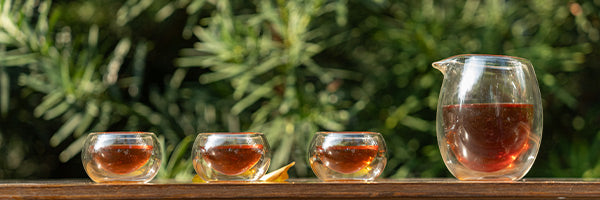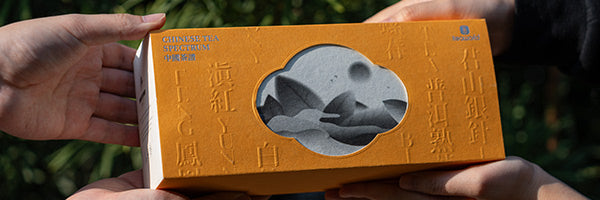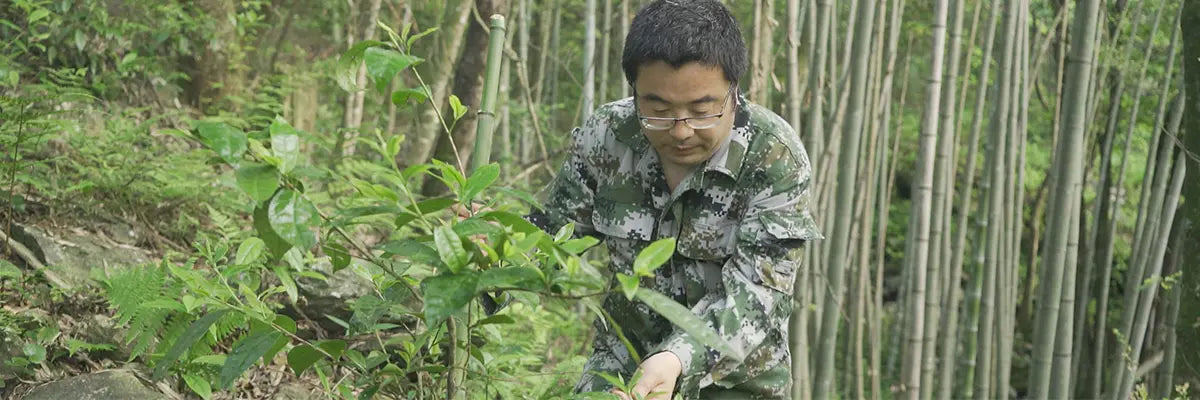Китайский чай имеет множество разновидностей, и в зависимости от степени ферментации и методов производства его можно разделить на шесть основных типов: листовой зеленый чай, листовой желтый чай, листовой белый чай, листовой черный чай, листовой улун и листовой темный чай.
Среди шести основных видов китайского чая каждый имеет свой уникальный шарм и ценность, а также похвальные преимущества для здоровья, которые стоит изучить. Многие люди могут чувствовать себя немного ошеломленными, впервые войдя в мир китайского листового чая , поскольку существует множество информации и вариантов, которые можно понять и попробовать.
Учитывая богатое разнообразие китайского чая, каждому рекомендуется ознакомиться с ним с помощью дегустатора листового чая , который обеспечивает экономичный и удобный способ попробовать и оценить различные сорта.
Листовой зеленый чай и его польза для здоровья
О листовом зеленом чае:

Листовой зеленый чай — наиболее производимый тип чая в Китае. Он относится к категории неферментированного чая, основными этапами обработки которого являются Shaqing (уничтожение зеленого), Rounian (скручивание) и сушка.
Характеристики листового зеленого чая включают прозрачный и яркий чайный настой, имеющий светло-зеленый или желто-зеленый цвет. Чайный настой освежающий, с длительным ароматом и мягким, нежным и гладким вкусом.
Польза для здоровья листового зеленого чая:
Листовой зеленый чай, с его нежным сырьем и неферментированной природой, максимально сохраняет свежесть и натуральные вещества в листьях. Антиоксидантные, омолаживающие, противораковые, антибактериальные и противовоспалительные свойства листового зеленого чая значительно выше, чем у других видов чая.
Кроме того, листовой зеленый чай способствует снижению веса, уменьшению жировых отложений, профилактике кариеса, освежению дыхания и снижению уровня липидов в крови.
Представители листового зеленого чая:
Включает Лунцзин, Билуочунь, Синьян Маоцзянь, Белый чай Анжи, Эньши Юлу, Хуаншань Маофэн и другие.
Найдите больше листового зеленого чая в нашем Green Tea Sampler.>>>
Листовой белый чай и его польза для здоровья
О листовом белом чае:

Листовой белый чай относится к категории слабоферментированного чая, его основная обработка включает в себя Weidiao (завяливание) и сушку (сушку на воздухе или выпечку). Для листового белого чая часто выбирают сорта с большим количеством белых пушистых волосков на листовых почках. В зависимости от собранных частей листовой белый чай делится на почечный и листовой.
Старый белый чай особенно популярен в категории листового белого чая. Настой старого белого чая прозрачно-красный, с обильным белым пухом, богатым и стойким ароматом, сладким и мягким вкусом и гладкой и клейкой текстурой.
Польза для здоровья листового белого чая:
Поскольку он не подвергался высокотемпературной фиксации, листовой белый чай имеет потенциал для постферментации или старения. Проще говоря, он известен своей «долговечностью», и есть поговорка, которая гласит: «Годовой чай, трехлетнее лекарство, семилетнее сокровище».
Белый листовой чай богат различными витаминами и минералами, проявляет антиоксидантные и антибактериальные свойства. Он может усилить функцию иммунной системы, помочь снизить уровень холестерина, улучшить здоровье сердца и предотвратить старение кожи.
Представители листового белого чая:
Включает, среди прочего, Байхао Иньчжэнь (Серебряная игла), Бай Мудань (Белый пион), Шумей и Гунгмей.
Листовой желтый чай и его польза для здоровья
О листовом желтом чае:

По сравнению с другими видами чая, разнообразие листового желтого чая относительно ограничено, что делает его нишевым выбором. Метод обработки желтого чая включает Shaqing (уничтожение зеленого), Rounian (скручивание), Menghuang (покрытие и пожелтение) и сушку. Характерной чертой желтого чая является «желтый ликер и желтые листья», результат процесса «menghuang» во время производства чая.
Характерные черты листового желтого чая включают яркий настой гусино-желтого цвета, чистый и мягкий аромат, сладкий вкус и длительное послевкусие.
Польза для здоровья листового желтого чая:
Сырье для желтого листового чая нежное, а технология обработки похожа на технологию обработки зеленого чая, что приводит к схожим преимуществам для здоровья. Однако желтый чай проходит дополнительный процесс «мэнхуан» по сравнению с зеленым чаем, что делает его вкус более мягким и менее охлаждающим по своей природе.
Листовой желтый чай сохраняет более 85% натуральных веществ, содержащихся в свежих листьях, обеспечивая превосходные антиоксидантные, антибактериальные и противовоспалительные свойства.
Кроме того, как постферментированный чай, ферментативная активность, производимая в процессе «мэн», помогает защитить селезенку и желудок, улучшить аппетит и помочь пищеварению. Пищеварительные ферменты могут восстановить функцию метаболизма жировых клеток, способствуя устранению жира.
Представители листового желтого чая:
В их число входят, среди прочего, Цзюньшань Иньчжэнь, Хуошань Хуанья, Мэндин Хуанъя, Ванцзыси Хуанда Ча и Гуандун Дайе Цин.
Листовой чай улун и его польза для здоровья
О листовом чае улун:

Листовой улун относится к категории полуферментированного чая, занимая промежуточное положение между неферментированным чаем (листовой зеленый чай) и полностью ферментированным чаем (листовой черный чай). Его внешний вид характеризуется зеленовато-коричневым цветом.
Из-за различий в сортах улун подразделяется на четыре типа: северофуцзяньский улун, южнофуцзяньский улун, гуандунский улун и тайваньский улун.
Характерными особенностями листового чая улун являются насыщенный и мягкий вкус, сильный и приятный аромат, сбалансированный и свежий вкус, стойкий аромат и длительное сладкое послевкусие.
Польза для здоровья листового чая улун:
Листовой чай улун, известный своим сильным ароматом, обладает прекрасным тонизирующим эффектом. Некоторые полифенолы в листьях улуна превращаются в чайные пигменты во время обработки, обеспечивая антиоксидантный, растворяющий жир и снижающий артериальное давление эффект.
Листовой улун также является хорошим выбором для снижения веса, показывая положительные эффекты похудения. Кроме того, употребление листового улуна помогает поддерживать более высокий уровень витамина С в крови и снижает выведение витамина С с мочой.
Представители листового чая улун:
В их число входят, среди прочих , Да Хун Пао , Фэнхуан Даньцун, Дун Дин Улун, Те Гуаньинь и Дунфан Мейрен.
Найдите больше листового чая улун с помощью нашего пробника чая улун.>>>
Листовой черный чай и его польза для здоровья
О листовом черном чае:

Листовой черный чай — это полностью ферментированный чай, основные этапы обработки которого включают Weidiao (завяливание), Rounian (скручивание), окисление и сушку. Качественные характеристики красного настоя и красных листьев листового черного чая в основном формируются в процессе «ферментации».
Аромат листового черного чая обычно сладкий, варьирующийся в зависимости от конкретных характеристик различных сортов черного чая. Вкус чайного настоя обычно крепкий, со сладким или мягким послевкусием.
Польза для здоровья листового черного чая:
В процессе производства листового черного чая образуются такие компоненты, как теафлавины и теарубигины, которые играют важную роль в определении цвета, вкуса и аромата чая. Теафлавины, также известные как «мягкое золото» чая, оказывают превосходное воздействие на регулирование липидов в крови и снижение уровня холестерина.
Листовой черный чай с его мягким вкусом и насыщенным ароматом способствует пищеварению, уменьшает жирность, стимулирует аппетит, улучшает самочувствие и повышает аппетит.
Представители листового черного чая:
Среди них — Лапсанг Сушонг , черный чай Кимун, черный чай Юньнань и черный чай Индэ .
Найдите больше листового черного чая в нашем пробнике черного чая.>>>
Листовой темный чай и его польза для здоровья
О листовом темном чае:

Листовой темный чай — это постферментированный чай, основные этапы обработки которого включают Shaqing (уничтожение зеленого), Rounian (скручивание), Wodui (ферментация в куче) и сушку. Сырье для листового темного чая обычно грубое и выдержанное, и из-за частого увеличения времени ферментации во время производства листья приобретают маслянистый черный или черно-коричневый цвет, отсюда и название «темный чай».
Характерные особенности листового темного чая включают оранжево-желтый цвет настоя, чистый аромат и мягкий вкус с легкой терпкостью.
Польза для здоровья листового темного чая:
Листовой черный чай подвергается высокой степени ферментации, часто с участием микроорганизмов, в результате чего преобразуется множество полезных для организма человека веществ.
Листовой черный чай содержит различные витамины и минералы, проявляя антиоксидантные и противовоспалительные эффекты. Он может помочь снизить уровень холестерина, улучшить пищеварение, облегчить запоры и снять дискомфорт в желудке.
Кроме того, листовой черный чай может усилить функцию иммунной системы, способствуя защите здоровья сердца.
Представители листового темного чая:
Включите, среди прочего, спелый пуэр из Юньнани, темный чай Аньхуа, чай Гуанси Любао и Хубэй Цинчжуань.
Мир китайского листового чая невероятно богат. Надеюсь, эта статья поможет всем получить некоторое представление о шести основных видах китайского чая.
Чтобы по-настоящему оценить красоту китайского листового чая, лучше всего попробовать его лично. Пробники листового чая предлагают различные небольшие упаковки чая, что позволяет вам приобрести пробники определенных сортов, таких как черный чай или улун. Таким образом, затратив минимум времени и усилий, вы можете найти лучший листовой чай , который соответствует вашим предпочтениям, путем практического исследования.
Выше приведены шесть основных видов чая в Китае. Если вы хотите попробовать эти шесть видов чая сразу и не хотите тратить слишком много денег, то я настоятельно рекомендую вам попробовать Chinese Tea Sampler . Это последний продукт, выпущенный iTeaworld. В одной коробке содержится шесть видов чая. Категории чая включают улун, зеленый чай, черный чай, желтый чай, белый чай и темный чай. И это не требует больших затрат, вы можете попробовать его один раз по самой низкой цене. Кроме того, есть также бесплатные чайные пакетики из кукурузного крахмала. Это делает более удобным наслаждение чаем в офисе.
На самом деле, количество знаний о чае, которыми вы обладаете, не является самым важным фактором. Оценка и изучение чая происходят из практического опыта. Самое главное, находите радость в дегустации чая и позвольте чаю стать расслабляющим и полезным спутником в вашей повседневной жизни.











































































